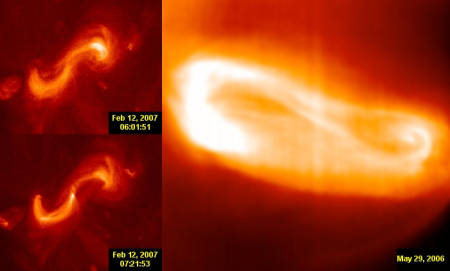|
|
Sigmoids - An Answer to Venus' Polar Vortex Mystery?
by Michael Gmirkin
|
|
May 16, 2009
|
|
|
|
The revelation that solar flare precursors (sigmoids) are
largely electrical in nature may yield an unexpected explanation
of a longstanding mystery at Venus. Can the electric theory derived
from the study of sigmoids also be applied to the double-eyed
vortices at Venus' poles, killing two birds with one stone?
|
|
|

Left: Evolution of a sigmoid (solar flare precursor).
Credit: NASA / STFC / ISAS / JAXA / A. Hood (St. Andrews),
V. Archontis (St. Andrews).
Right: Double-eyed vortex at Venus' south pole.
Credit: ESA / VIRTIS / INAF-IASF / Obs. de Paris-LESIA
[Click to enlarge]
|
|
|
Venus' double-eyed polar vortices have stymied researchers
since they were first reported. In 2006,
data
from Venus Express surprised observers with the presence of a massive
double-eyed vortex at Venus' south pole. Previous data had hinted at
a double-eyed vortex at the north pole of the planet as well. Nobody
has yet determined why such vortices should be double-eyed.
…we are still not able to explain why the global atmospheric
circulation of the planet results in a double and not single
vortex formation at the poles.
Higher resolution
close-up
imaging only confounded the issue by detailing a highly
dynamic fine structure linking the two eyes of the south polar vortex.
However, not all hope of resolving the mystery is lost. The answer
may lie in the fields of electrodynamics and plasma physics.
Recently
announced findings from the Hinode team about the precursors
of solar flares might just be an unexpected watershed moment for
understanding the physics of Venus as well.
'Sigmoids' are S-shaped structures found in the outer atmosphere
of the Sun (the corona) … the structure of the sigmoid is complex:
it consists of many, differently oriented, loops that all together
form two opposite J-like bundles or an overall S-shape.
When compared side-by-side, the sigmoids bear a striking similarity
to the fine structure of the Venusian double-eyed polar vortices
(as shown above).
The new model describes how sigmoids consist of many thin and
twisted layers (or ribbons) of strong electric current.
It is the contention of this article that the similarity is more
than superficial and that further investigation of the Venusian
poles should concentrate on determining whether the electrodynamic
interpretation is correct. What's good for the goose is good for
the gander.
In fact, this is not the first time that such an interpretation
has been offered. In
a
2006 article, Australian plasma physicist Wallace Thornhill commented:
Of particular interest are the linear filaments sometimes seen
connecting the opposite sides of the hot spots [in Venus'
double-eyed vortices]. Taylor writes: “It is virtually
impossible, even with complete license, to begin to speculate
in any detail as to what mechanism could give rise to such a
curious effect.” The answer, in the Electric Universe model
is simple. They are a feature seen in simulations of the behavior
between two converging Birkeland current filaments where plasma
becomes trapped in the elliptical core between them.
Furthermore, Thornhill has also
conjectured
that the same mechanism will apply equally well to the fine structure
of Saturn's polar vortices, once sufficiently resolved by more sensitive
instruments.
The image [of Saturn's polar vortex in infrared], while being incomplete,
supports the electrical model. At around 300˚ we see the yellow-reddish
cusp feature of one Birkeland filament. At intervals, heated gas from that
filament is 'squirted' in a thin jet into the central 'sump,' indicated
by the reddish patch over the pole. The inward jets alternate between
the two filaments so we may expect the pattern to be repeated where
the infrared data is missing.
It seems that a single unifying theory (utilizing electrodynamics)
may soon be able to conceptually unify the otherwise disparate
processes of solar flare precursors and the polar vortices of
Venus and even Saturn. While more work certainly needs to be done
to validate the relationship, this is a promising new insight, if
researchers in the field choose to acknowledge and pursue it.
Michael Gmirkin
|
|
|
Permalink to this article.
Public comment may be made on this article on the
Thunderbolts Forum/Thunderblogs (free membership required).
|
|
|
|
|
|
|





